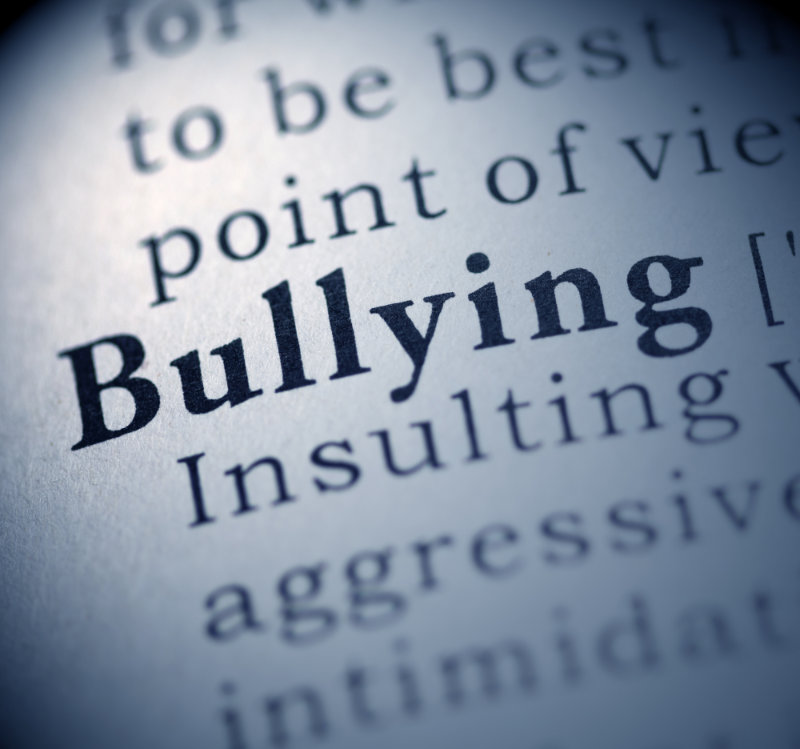Bullying and Cyberbullying
What is Bullying?
Bullying is mean, cruel, hurtful behaviour. It involves using power in a negative way to hurt others. We all have the power to make a huge difference in stopping and preventing bullying.
Bullying is NOT a normal part of growing up
Until recently, many people thought bullying in schools was normal—something most children and youth would have to experience at some point in their lives, and that made them stronger. Today we know that bullying and harassment have serious consequences for everyone involved. People who have been bullied can experience depression, substance misuse, criminal behaviour and even suicide. People who do bullying can also experience negative long-term effects, including problems with having healthy relationships when they become adults.
Bullying is different from friendly teasing
There is a difference between bullying and friendly teasing. An important factor to consider is the intent of the person—were they intending to hurt the other person? Often there is no intent to harm the other person in a situation where the teasing is friendly. However, some teasing crosses the line, is not friendly and can become bullying behaviour.
Bullying is based on a power difference
Bullying is based on an imbalance of power or strength. Youth who bully have more power than the people they target. People primarily gain power through age, popularity, social status, size, physical strength, having more financial resources, or having more information and expertise on a topic.
Bullying is usually repeated over time
Bullying rarely happens just one time and usually involves the same person being targeted over and over again. This makes it really hard for the person being targeted to escape from the bullying.
Eighty-five per cent of bullying happens in front of an audience
Many children and youth are witnesses or bystanders in bullying situations. Some will watch the behaviour and do nothing, and others will encourage the bullying behaviour.
Standing up and intervening in bullying situations can make a difference
When children and youth stand up and intervene—more than half the time—bullying will stop in 10 seconds or less. We all have the power to make a huge difference in stopping and preventing bullying.
What is Cyberbullying?
Cyberbullying is bullying through electronic media
Electronic bullying or “cyberbullying” is using electronic media to be hurtful or mean to other people. Social media is/can be used to threaten, embarrass, intimidate, exclude or damage someone’s reputation.
Some examples of cyberbullying are:
- Posting or sending mean, cruel comments by text, on Facebook or other social media sites
- Hacking email or social media accounts and impersonating another person to do mean or harmful things like posting innapropriate pictures or embarrassing comments
- Sending embarrassing pictures of another person over cell phones
- Posting YouTube videos of people and modifying them to humiliate the person in the video
- Setting up polls or websites to vote on who is the ugliest or most stupid person in the school.
Cyberbullying is different than face-to-face bullying.
- Cyberbullying can be anonymous and most often you do not know who the person is that is making the hurtful comments.
- People tend to say more hurtful, cruel things because of the anonymity.
- The person doing the cyberbullying has more bystanders watching and doing nothing…the whole world is on the Internet.
- The person doing the cyberbullying does not have to see the reaction and pain of the person they are hurting.
- It is very difficult for the person being targeted by cyberbullying to get away from it because most people have computers and cell phones.
What strategies can you use as a student to stop bullying and cyberbullying?
Use W.I.T.S. and L.E.A.D.S.
Walk Away – Leaving the situation takes you out of the conflict or bullying situation … leave calmly and quickly and get somewhere safe (classroom, find an adult, find a group of friends)
Ignore – kids who bully are looking for a reaction from you … when you ignore them they do not get the response they are looking for … stay calm, keep doing what you were doing or go hang out with other people who are supportive of you
Talk it Out – stand up for yourself and your friends around you …Say, “Please stop”, tell them “That’s rude”. Use “I” statements, like “I feel hurt when you say that”. Talk firmly, without name-calling. Don’t turn around and be mean or bully-the-bully because this makes it worse.
Seek Help – most of the time there are adults around to help you …Get help if you or someone could get hurt, if you’re afraid, if you can’t handle it alone, or if your attempts did not work. Seeking help is not “tattling” or “ratting out people”. When you get help, you’re making your school and community safe for everyone!
LEADS is:
Look and Listen – develop an understanding of what can be learned about others’ feelings, intentions, and inner thoughts by carefully observing their behaviours and nonverbal expressions, and by listening to others. If you sense that someone is angry by the way they look then you are probably right and should be careful in your interaction with that person.
Explore Points of View – understand others’ points of view, see how words, thoughts and feelings can vary for different people, look and listen to words, thoughts and feelings. There will almost always be a difference of opinion about what happened in a situation because everyone is different and how each person views a situation is going to be slightly different from you. You owe it to the other person to respect their point of view the same way you want them to understand your point of view.
Act – understand others’ points of view, see how words, thoughts and feelings can vary for different people, look and listen to words, thoughts and feelings. This will help you to understand how people act and what is motivating them to act the way they do. Sometimes a person will react to a situation in a way that you don’t expect. That person is not wrong, they are just different from you. Try to put yourself in the other person’s place to help you understand how and why they acted the way they did in a situation.
Did it Work? – identify the short- and long-term consequences of actions chosen to deal with a conflict, identify those factors that suggest a solution has worked, demonstrate social responsibility by solving problems and resolving conflicts in peaceful ways, learn to exercise democratic rights and responsibilities, recognize different types of bullying and the roles of bystanders in refusing and reporting it. When we try to find a win-win solution to conflicts, we are exhibiting leadership qualities.
Seek Help – learn when to seek help from an adult and when to handle a problem independently, learn to use the WITS LEADS problem solving skills together, learn to identify and solve problems. Sometimes we can not agree with another person or we cannot come up with a solution that is win-win by ourselves. Don’t be afraid to ask for a third person to help you.
Is it peer conflict, mean behaviour or bullying?
Please find attached below and information sheet that talks about peer conflict and mean behaviour compared to bullying. I get asked this a lot by students and parents. Disagreements or conflict between students is not bullying. Excluding someone from play time or saying or acting unkindly is also not bullying.
Bullying is a repetitive behaviour that continues over time. It is not accidental or spontaneous and is usually meant to hurt the other person – emotionally or physically. Third, bullying behaviour happens when one child has power over another student or there is a power imbalance between them.
More info can be found below:


